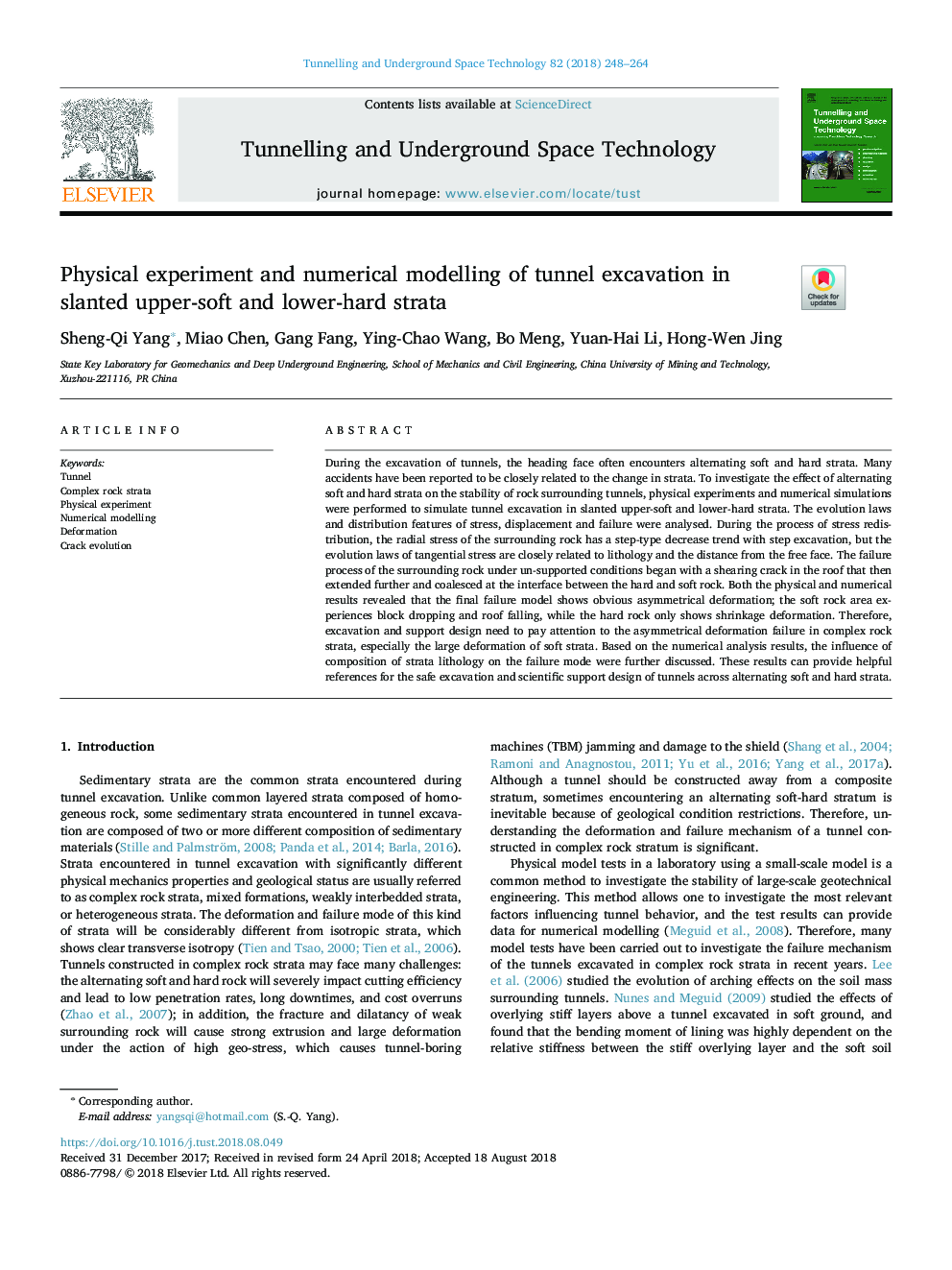| کد مقاله | کد نشریه | سال انتشار | مقاله انگلیسی | نسخه تمام متن |
|---|---|---|---|---|
| 11001356 | 1432264 | 2018 | 17 صفحه PDF | دانلود رایگان |
عنوان انگلیسی مقاله ISI
Physical experiment and numerical modelling of tunnel excavation in slanted upper-soft and lower-hard strata
ترجمه فارسی عنوان
آزمایش فیزیکی و مدلسازی عددی حفاری تونل در لاغرهای بالا و پایین سخت
دانلود مقاله + سفارش ترجمه
دانلود مقاله ISI انگلیسی
رایگان برای ایرانیان
کلمات کلیدی
تونل، سنگهای مجتمع سنگی، آزمایش فیزیکی، مدل سازی عددی، تغییر شکل، ترک تکامل،
ترجمه چکیده
در حین حفاری تونلها، صورت اغلب با سختی های نرم و سخت متضاد روبرو می شود. گزارش شده است که بسیاری از حوادث مربوط به تغییر در اقشار است. برای بررسی اثر تنشهای نرم و سخت متناوب بر پایداری تونل های سنگی اطراف، آزمایش های فیزیکی و شبیه سازی های عددی برای شبیه سازی حفاری های تونل در لایه های افقی و نرم، انجام شد. قوانین تکاملی و ویژگی های توزیع تنش، جابجایی و شکست، مورد تجزیه و تحلیل قرار گرفت. در طی روند بازتوزیع تنش، تنش شعاعی سنگ اطراف، یک روند کاهش قدم به قدم با کاشت گام دارد، اما قوانین تکاملی تنش مماسی به علت سنگ شناسی و فاصله از چهره آزاد، نزدیک است. فرآیند شکست سنگ اطراف تحت شرایط غیر پشتیبانی با یک ترک در قوس شکسته آغاز شد که بعد از آن گسترش بیشتری یافت و در میان سنگ سخت و نرم با هم ترکیب شد. هر دو نتایج فیزیکی و عددی نشان داد که مدل شکست نهایی نشان دهنده تغییر شکل نامتقارن است؛ منطقه نرم سنگ تجربه بلوک کاهش و سقوط سقوط، در حالی که سنگ سخت تنها نشان می دهد تغییر شکل کوچک شده است. بنابراین، طراحی حفاری و حمایت باید توجه به شکست شکست نامتقارن در سنگ های پیچیده سنگ، به ویژه تغییر شکل بزرگ نخی نرم است. بر اساس نتایج تجزیه و تحلیل عددی، تأثیر ترکیب سنگ شناسی سطوح در حالت شکست بیشتر مورد بحث قرار گرفت. این نتایج می تواند مراجع مفیدی برای حفاری ایمن و طراحی علمی حمایت از تونل ها در زمینه های نرم و سخت متناوب ارائه دهد.
موضوعات مرتبط
مهندسی و علوم پایه
علوم زمین و سیارات
مهندسی ژئوتکنیک و زمین شناسی مهندسی
چکیده انگلیسی
During the excavation of tunnels, the heading face often encounters alternating soft and hard strata. Many accidents have been reported to be closely related to the change in strata. To investigate the effect of alternating soft and hard strata on the stability of rock surrounding tunnels, physical experiments and numerical simulations were performed to simulate tunnel excavation in slanted upper-soft and lower-hard strata. The evolution laws and distribution features of stress, displacement and failure were analysed. During the process of stress redistribution, the radial stress of the surrounding rock has a step-type decrease trend with step excavation, but the evolution laws of tangential stress are closely related to lithology and the distance from the free face. The failure process of the surrounding rock under un-supported conditions began with a shearing crack in the roof that then extended further and coalesced at the interface between the hard and soft rock. Both the physical and numerical results revealed that the final failure model shows obvious asymmetrical deformation; the soft rock area experiences block dropping and roof falling, while the hard rock only shows shrinkage deformation. Therefore, excavation and support design need to pay attention to the asymmetrical deformation failure in complex rock strata, especially the large deformation of soft strata. Based on the numerical analysis results, the influence of composition of strata lithology on the failure mode were further discussed. These results can provide helpful references for the safe excavation and scientific support design of tunnels across alternating soft and hard strata.
ناشر
Database: Elsevier - ScienceDirect (ساینس دایرکت)
Journal: Tunnelling and Underground Space Technology - Volume 82, December 2018, Pages 248-264
Journal: Tunnelling and Underground Space Technology - Volume 82, December 2018, Pages 248-264
نویسندگان
Sheng-Qi Yang, Miao Chen, Gang Fang, Ying-Chao Wang, Bo Meng, Yuan-Hai Li, Hong-Wen Jing,
